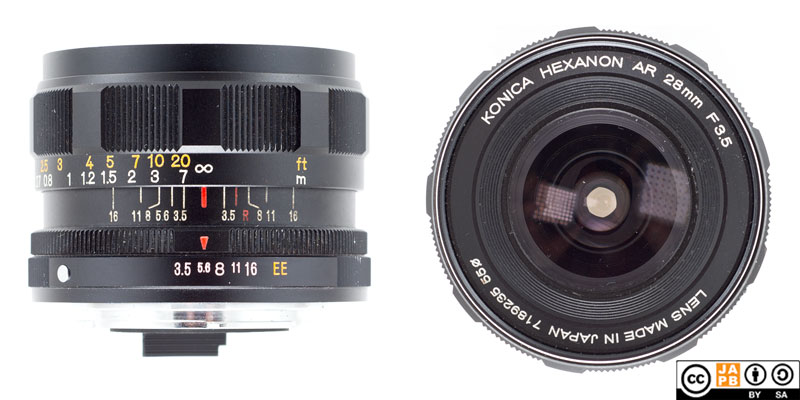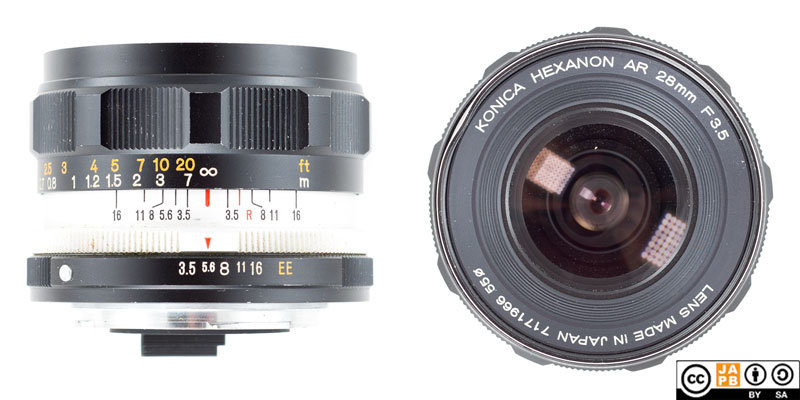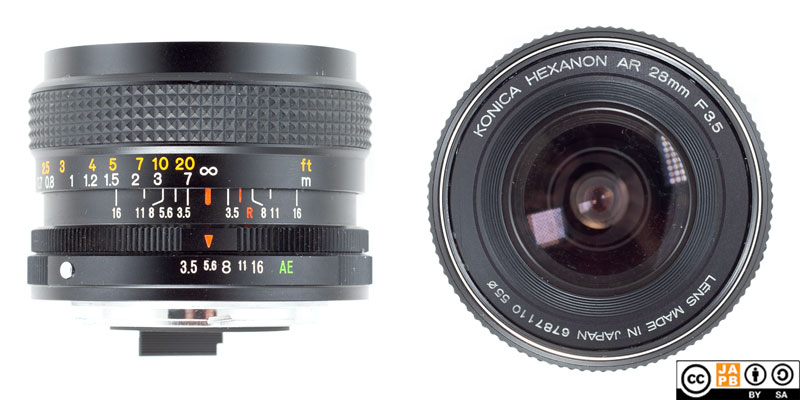Pekka Buttler, 08/2022 (Updated 03/2024 with pictures on versions 2 and 4)

Specifications
The table below summarizes the lens’ key specifications (measurements based on the pictured sample above:
| Brand: | Konica | Lens name | HEXANON AR 28mm F 3.5 |
| Focal length 1 | 28 mm | Angle-of-view 2 | 75° |
| Maximum Aperture | f/3.5 | In Production | 1967–1978 |
| Lens mount | Konica AR | Subfamily (if applicable) | –– |
| Length 3 | 44,7 mm | Diameter 4 | 62,7 mm |
| Filter ring diameter | 55 mm | Weight | 213 grams |
| Lens element count | 7 | Lens group count | 7 |
| Aperture blades (S/R/C) 5 | 6 S | Focus throw | 220 ° |
| Minimum focusing distance | 30 cms | Maximum magnification | 1:8,6 |
| Has manual aperture ring | YES | Has Manual focus ring | YES |
| Aperture mechanism type | Automatic | Aperture click stops 6 | 3.5•5.6•8•11•16 (v1–2) 3.5-5.6-8-11-16 (v3–4) |
Further notes:
The Konica 28/3.5 exists in at least 6 significant cosmetic/ergonomic variants and – importantly – in three optically distinct versions:
• The first (≈1965–1967) version was a preset lens with a 7 elements in 6 groups design.
• The second (≈1967–1978) version was an auto aperture lens with a 7 elements in 7 groups design
• The third (1978–1987) version was an auto aperture lens with a 5 elements in 5 groups design.
This article covers the second version, while the third (and most commonly available) version is covered in a separate article.
Konica offered a rectangular, clamp-on hood for this lens (the same hood was also offered for the Konica Hexanon 24/2.8).
Because there are some misconceptions about how to distinguish a 7/7 version from a 5/5 version (no, the rubber focus ring does not do, neither does the green AE indication, and unless you can compare them side-by-side, the size difference is also not really clear), the real giveaway is the minimum aperture as all 5-element versions go all the way to f/22, while all 7-element versions are limited to f/16.
History of Konica AR lenses
Konica is one of those names that will not ring any bells to those who’ve only recently started photographing, but for many years Konica was one of the ‘Great Japanese camera companies’.
After a short-lived and only moderately successful line of SLR cameras known as the Konica F-line (1960-1965), Konica hit pay dirt with the introduction of the Konica Auto-Reflex in 1965 and its new, Konica AR mount. The Auto-Reflex was at the time the first affordable system camera with integrated auto-exposure (albeit the exposure metering was not yet TTL). The Auto-Reflex was followed by a two lines of successful cameras – the more ambitious Autoreflex T-line and the more pedestrian Autoreflex A-line – before Konica (along with the rest of Japanese camera companies) stepped up the automation of their SLR cameras with the 1-series (FS-1, FC-1, FP-1, and FT-1).
But while Konica had often been at the forefront of automation (first shutter priority auto-exposure system, first SLR with integrated winder), Konica’s star had been waning, and Konica decided to not compete against the likes of Minolta, Nikon, Canon, and Pentax in autofocus technology. Instead Konica withdrew from SLR and SLR lens manufacture and focused on compacts and other optoelectronics. Two decades later Konica merged with Minolta to form KonicaMinolta, which subsequently sold its camera business to Sony. So, after a fashion, the DNA of Konica’s camera business lives on in Sony’s camera division.
Relevantly, the Konica AR mount had a relatively good and long (1965–1987) run, and stayed remarkably unchanged throughout. Hence, while Konica changed the design of their AR lenses during those years – moving towards lighter constructions, rubber focus rings, and a more modern look (for more detail, look here) – all AR lenses are physically entirely compatible with all AR-mount bodies.´
Versions
This lens was always the widest affordable Konica lens. Combined with Konica’s later decision to (at least in some markets) starting to offer triple kits (body+28/3.5+nifty fifty+135/3.5) makes the Konica 28/3.5 one of the most readily available legacy wide-angles (even though most of those are of the third version).
As noted, Konica made several changes to their basic 28/3.5 recipe over the 20+ years of the Konica AR mount’s history. In this article I will only comment on the variations of the lens that followed the 7 elements in 7 groups design:
In short, there are four cosmetic variants:
Version 1 (1965–67)
– Metal focusing ring
– Chrome ring
– Glossy finish
– min aperture 16
– Yellow EE
Version 2 (1967-1970)

Version 2 characteristics:
– Metal focusing ring
– Chrome ring
– Matte finish
– min aperture 16
– Yellow EE
Version 3 (1970-1973)

Version 3 characteristics:
– Metal focusing ring
– All black
– Matte finish
– min aperture 16
– Yellow EE
Version 4 (1973-1977)

Version 4 characteristics:
– Rubber focusing ring
– Matte finish
– min aperture 16
– Green AE
Adapting
n.B! The following applies to all Konica AR mount lenses.
This lens cannot be used natively on any current SLR or dSLRs. To use it in its native environment, you will need a Konica AR-mount film body.
Thanks to being a fully manual lens (manual aperture, manual focus), the lens can be adapted to all mirrorless cameras using a suitable adapter. Moreover, Konica AR lenses are so uncomplicated that a simple ‘dumb adapter’ will do the job perfectly. However, due to Konica AR lenses not being among the most numerously manufactured, special adapters (helicoid adapters, tilt/shift adapters) are not easy to come by and speed boosters are currently unavailable.
Using Konica AR lenses on dSLRs is possible, but difficult. Due to the exceptionally short flange focal distance of the Konica AR mount (at 40,5 mm, a lot shorter than that of any full-frame dSLR mount), any adapter will necessitate some optics to achieve anything near infinity focus.
Footnotes
- Focal length is (unless stated otherwise) given in absolute terms, and not in Full-frame equivalent. For an understanding of whether the lens is wide/tele, see ‘Angle-of-view’. ↩︎
- Picture angle is given in degrees (based on manufacturers’ specs) and concerns the diagonal picture angle. Rule of thumb:
> 90 ° ==> Ultra-wide-angle
70–90 ° ==> Wide-angle
50–70 ° ==> Moderate wide-angle
40–50 ° ==> ‘Standard’ or ‘normal’ lens
20–40 ° ==> Short tele lens
10-20 ° ==> Tele lens
5-10 ° ==> Long tele lens
< 5 ° ==> Ultra-tele lens ↩︎ - Length is given from the mount flange to the front of lens at infinity. ↩︎
- Diameter excludes protrusions such as rabbit ears or stop-down levers. ↩︎
- S=straight; R=rounded; C=(almost)circular at all apertures. ↩︎
- Numbers equal aperture values on aperture ring; • intermediate click; – no intermediate click. ↩︎